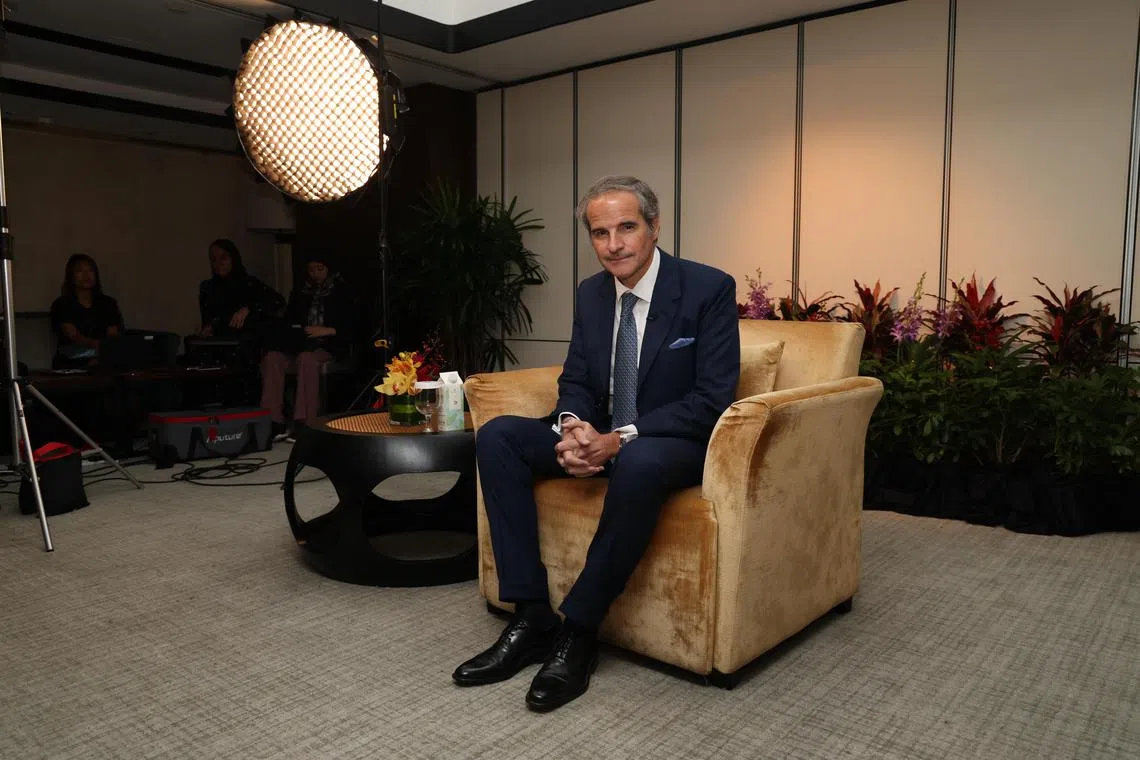On Singapore visit, IAEA head addresses nuclear waste and energy plans
Sign up now: Get ST's newsletters delivered to your inbox

IAEA head Rafael Grossi said the UN nuclear body has a method to assist countries that are considering or planning their first nuclear power plant.
PHOTO: LIANHE ZAOBAO
Follow topic:
SINGAPORE – Mr Rafael Grossi, director-general of the International Atomic Energy Agency (IAEA), was in Singapore on July 25 to meet leaders and deliver a public lecture at NUS.
To mark his first visit to Singapore, he also met the local media for an hour-long interview at Shangri-La Singapore
A range of issues were discussed, including on nuclear waste, Asia’s bid to harness more nuclear energy and China’s nuclear reactor manufacturing.
Here are his takes.
Q: What are the possible options for nuclear waste disposal in Asean?
A: Mr Grossi said there are a number of steps involved in the proper disposal of nuclear waste.
“In the case of a nuclear power plant, for quite a long period, the spent fuel is stored at the site of the nuclear power plant,” he said. Spent fuel refers to nuclear fuel that has been removed after being used in a nuclear reactor.
Used fuel is normally stored underwater – with the practice known as wet storage – for at least five years, before it is moved to dry storage, according to the World Nuclear Association.
“Eventually, with time, with decades passing, countries start to look into a final repository,” Mr Grossi said.
The IAEA helps countries to determine this through a process known as siting, he added.
“What is done here is a very thorough geological analysis to determine which place (in) a country has geological conditions that would allow for the storage of a few containers of spent fuel that are going to be there without any leaks or without affecting the environment.”
Q: What is the appetite for nuclear energy in Asia and South-east Asia?
A: Mr Grossi said there is “a lot of activity” in the region, citing Japan, China and South Korea as examples of countries that are ramping up their nuclear energy capacities.
On Asean, he said: “There is a real interest. I don’t know if they’re going to be able to deploy (nuclear energy) by the early 2030s, but they are going in that direction.”
During a public lecture he delivered at the National University of Singapore on July 25
“On the feasibility of each case, (the IAEA) will be seeing it individually. We will be engaged, and we are,” he said. “The issue of the timeline is a national thing.”
The UN nuclear body has a method to assist countries that are considering or planning their first nuclear power plant. The IAEA also guides them through the process, from the decision-making to final investment and construction.
Q: China is building small modular reactors. Is this the latest technology for nuclear power plants?
A: Small modular reactors (SMRs) are advanced and compact reactors that can be factory-assembled and installed in dense urban areas. They are also known to be safer than traditional large reactors, but are currently still in a research phase.
Noting that Chinese technology is “very developed”, Mr Grossi said China might be one of the potential vendors of SMRs for Singapore if the Republic decides to tap nuclear energy.
“I think that China is perhaps the fastest-growing country in terms of the number of units being built at this point in time, and that creates a lot of expertise and a lot of experience,” he said.
According to the IAEA’s website, China operates 58 civil nuclear reactors and has almost 30 new builds in progress. This represents nearly half of all power reactors currently under construction worldwide.
The nation is expected to leapfrog the US to become the world’s largest atomic energy generator by the end of the decade, Bloomberg reported in April.
Q: How does the IAEA strike a balance between its two roles as the international authority for nuclear power and as the global watchdog for nuclear security?
A: Mr Grossi said that the IAEA is an impartial institution.
“I think every country that is operating normally and safely and with no proliferation concerns is a member of the IAEA in good standing,” he said.
Nuclear non-proliferation refers to efforts aimed at preventing the spread of nuclear weapons and weapons technology.
He added that these countries are transparent and undergo inspection by IAEA.
They also carry out safety and security reviews and participate actively in the regulatory activities.
“The IAEA is an impartial institution that is there in support,” Mr Grossi said, adding that the institution will share best practices and advice with countries.


